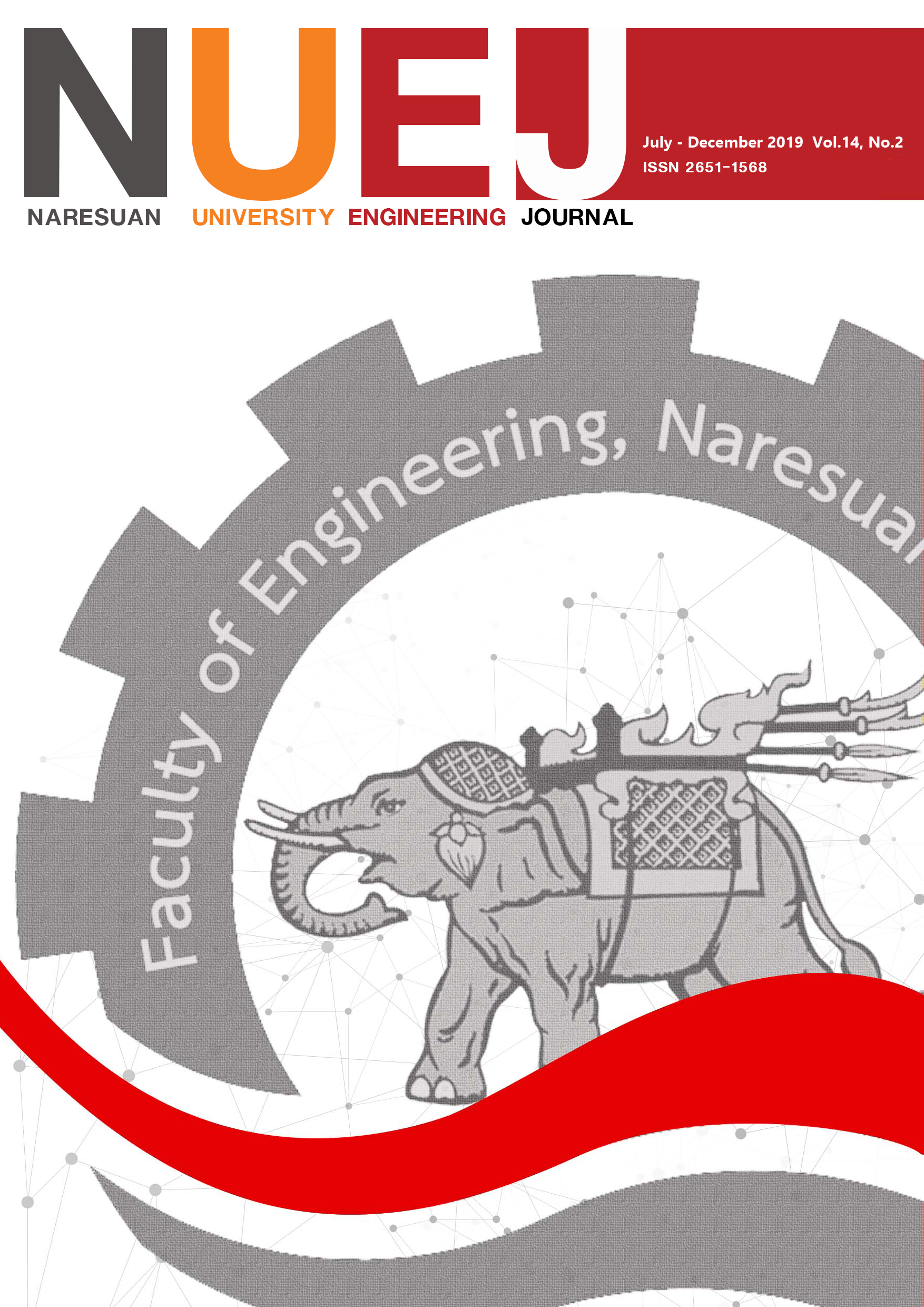การวิเคราะห์ทางสถิติของพารามิเตอร์คุณภาพน้ำบริเวณแม่น้ำน่านตอนล่างของประเทศไทย
Main Article Content
บทคัดย่อ
งานวิจัยนี้เป็นการวิเคราะห์คุณภาพน้ำของแม่น้ำน่านตอนล่างในระหว่างปี พ.ศ. 2555 - 2559 โดยใช้ข้อมูลผลการตรวจวัดคุณภาพน้ำ 15 พารามิเตอร์ (ข้อมูลทุติยภูมิ) จากสถานีเก็บตัวอย่างน้ำ 4 จุด ได้แก่ สถานี NA07, NA05, NA03 และ NA02 ของกรมควบคุมมลพิษ กระทรวงทรัพยากรธรรมชาติและสิ่งแวดล้อม ทั้งนี้ได้คำนวณค่าดัชนีคุณภาพน้ำทั่วไป (WQI) จาก 5 พารามิเตอร์หลัก ได้แก่ ออกซิเจนละลายน้ำ บีโอดี แบคทีเรียโคลิฟอร์มทั้งหมด แบคทีเรียฟีคัลโคลิฟอร์ม และแอมโมเนีย ร่วมกับการวิเคราะห์ด้วยโปรแกรมทางสถิติต่าง ๆ (เช่น ANOVA, t-test, SPSS) พบว่า ค่าเฉลี่ยของดัชนีคุณภาพน้ำทั่วไปลดลงอย่างมีนัยสำคัญตามระยะทาง โดยสถานี NA07 เป็นพื้นที่ติดกับแม่น้ำน่านตอนกลาง มีค่าประมาณ 70 สถานี NA05 เป็นพื้นที่ถัดลงไป มีค่าประมาณ 66 และสถานี NA03 และ NA02 เป็นพื้นที่ไกลที่สุด มีค่าประมาณ 62 และ 61 แม้ว่าค่าเฉลี่ยของดัชนีคุณภาพน้ำทั่วไปของทุกสถานีจะอยู่ในเกณฑ์พอใช้ อย่างไรก็ตาม ค่าต่ำสุดของดัชนีคุณภาพน้ำทั่วไปของสถานี NA05, NA03 และ NA02 อยู่ในเกณฑ์เสื่อมโทรม แม่น้ำน่านตอนล่างจึงจัดเป็นพื้นที่เสี่ยงต่อปัญหามลพิษทางน้ำ โดยพารามิเตอร์ที่ควรเฝ้าระวัง ได้แก่ บีโอดี แบคทีเรียโคลิฟอร์มทั้งหมด และแบคทีเรียฟีคัลโคลิฟอร์ม จากการวิเคราะห์องค์ประกอบหลัก พบว่าบีโอดีมีความสัมพันธ์ระดับสูงกับพารามิเตอร์ความขุ่น ของแข็งทั้งหมด และของแข็งแขวนลอย ขณะที่แบคทีเรียทั้งสองมีความสัมพันธ์ระดับสูงกับพารามิเตอร์กับพารามิเตอร์ความเป็นกรด-ด่าง ดังนั้น พารามิเตอร์ดังกล่าวข้างต้นสามารถใช้เป็นตัวแทนในการวิเคราะห์คุณภาพเบื้องต้น เพื่อป้องกันปัญหามลพิษทางน้ำของแม่น้ำน่านตอนล่างได้อย่างทันท่วงที
Article Details
เอกสารอ้างอิง
Abd-Elwahed, M.S. (2018). Influence of long-term wastewater irrigation on soil quality and its spatial distribution. Annals of Agriculture Science, 63, 191-199.
Adimalla, N., & Qian, H. (2019). Groundwater quality evaluation using water quality index (WQI) for drinking purposes and human health risk (HHR) assessment in an agricultural region of Nanganur, south India. Ecotoxicology and Environmental Safety, 176, 153-161.
Auppaman, S. (2019). Illegal dumping of industrial waste at Nong Nae sub-district, Phanom Sarakham district, Chachoengsao.Waste and Hazardous Substance Management Bureau. www.pcd.go.th
Carstens, D., & Amer, R. (2019). Spatio-temporal analysis of urban changes and surface water quality. Journal of Hydrology, 569, 720-734.
Chen, W., & Liu, W. (2017). Investigating the fate and transport of fecal coliform contamination in a tidal estuarine system using a three-dimensional model. Marine Pollution Bulletin, 116, 365-384.
Greenpeace. (2007). Groundwater crisis from intensive fertilizer use in Thailand. www.greenpeace.org/archive-thailand
Gu, Q., Hu, H., Ma, L., Sheng, L., Yang, S., Zhang X., Zhang, M., Zheng, K., & Chen, L. (2019). Characterizing the spatial variation of the relationship between land use and surface water quality using self-organizing map approach. Ecological Indicators, 102, 633-643.
Inland Water Quality, Water Quality and Management, Pollution Control Department. (2018). Practical guide for surface water quality monitoring. www.pcd.go.th
Inland Water Quality, Water Quality and Management, Pollution Control Department. (2013). Water quality annual report 2012. http://infofile.pcd.go.th/mgt/WaterQuality.pdf
Kacar, A. (2011). Analysis of spatial and temporal variation in the level of microbial fecal indicators in the major rivers flowing into the Aegean Sea, Turkey. Ecological Indicators, 11, 1360-1365.
Liang, W., & Yang, M. (2019). Urbanization, economic growth and environmental pollution: Evidence from China. Sustainable Computing: Informatics and System, 21, 1-9.
Liu, C., Lin, K., & Kuo, Y. (2003). Application of factor analysis in the assessment of groundwater quality in a Blackfoot Disease area in Taiwan. Science of the Total Environment, 313, 77-89.
Mainali, J., & Chang, H. (2018). Landscape and anthropogenic factors affecting spatial patterns of water quality trends in a large river basin, South Korea. Journal of Hydrology, 564, 26-40.
Pitakwinai, P., Khanitchaidecha, W., & Nakaruk, A. (2019). Spatial and seasonal variation in surface water quality of Nan river, Thailand. Naresuan University Engineering Journal, 14, 1-6.
Pollution Control Department. (2011). Calculation of water quality index with 5 parameters. Inland Water Quality Sub-Division, Water Quality Management Division. www.pcd.go.th
Pollution Control Department. (2016). Water Quality and Management annual report 2016. https://www.stkc.go.th/sites/default/files/ebook/1507797423.pdf
Pollution Control Department. (2019). Secondary data of downstream of Nan River during 2012-2016. https://www.pcd.go.th
Pollution Control Department. (2019). Surface water quality. www.pcd.go.th
Sener, S., Sener, E., & Davraz A. (2017) Evaluation of water quality using water quality index (WQI) method and GIS in Aksu River (SW-Turkey). Science of The Total Environment, 584-585, 131-144.
Soithong, P., Youngsai, P., & Wachirawongsakorn, P. (2013, December 19-20). Quality aspects of domestic wastewater and Nan river in Phitsanulok. The 7th Rambhai Barni Rejabhat University Research Conference, Buriram Rajabhat University, Thailand.
Sonklin, W., & Photong, C. (2005). Water quality of Nan river flowing through agricultural and urban areas of Phitsanulok Province. Naresuan University Journal, 13, 37-44.
Sun, W., Xia, C., Xu, M., Guo, J., & Sun, G. (2016). Application of modified water quality indices as indicators to assess the spatial and temporal trends of water quality in the Dongjiang River. Ecological Indicators, 66, 306-312.
Wang, J., Fu, Z., Qiao, H., & Liu, F. (2019). Assessment of eutrophication and water quality in the estuarine area of Lake Wuli, Lake Taihu, China. Science of The Total Envrionment, 650, 1392-1402.
Yang, X., Warren, R., He, Y., Ye, J., Li, Q., & Wang, G. (2018). Impacts of climate change on TN load and its control in a River Basin with complex pollution sources. Science of The Total Environment, 615, 115-1163.
Yaqub, M., & Lee, W. (2019). Zero-liquid discharge (ZLD) technology for resource recovery from wastewater: A review. Science of The Total Environment, 681, 551-563.


